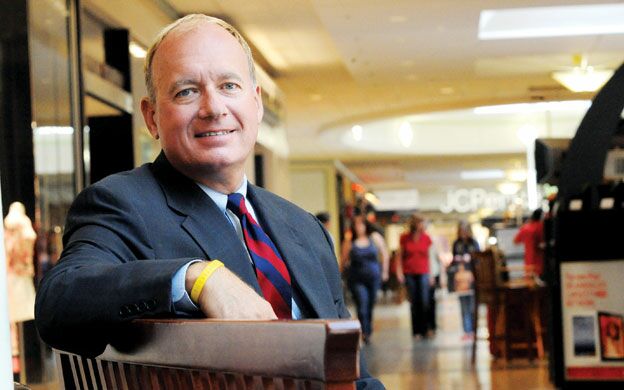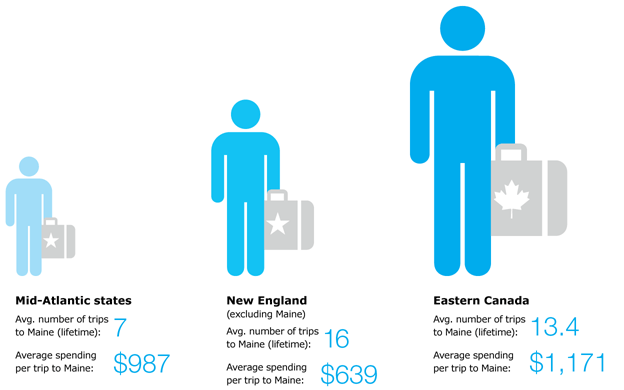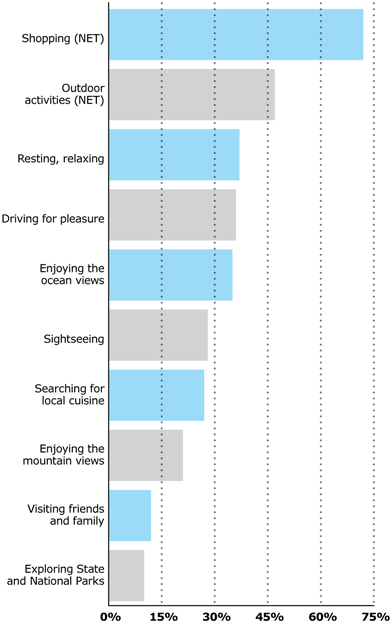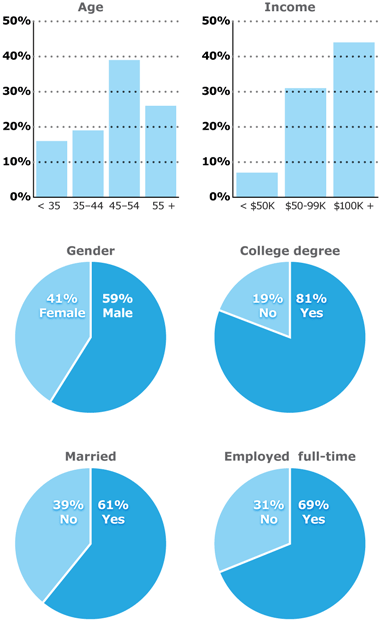Bargains, exchange rates drive Canadians to Maine to shop and stay
Late last October, James Gerety, general manager of the Bangor Mall, was driving on Bangor Mall Boulevard after leaving work, when he witnessed a Kodak moment: a sports utility vehicle with New Brunswick license plates chock full of shopping bags. So, at the next stop light, he pulled up close and snapped a picture with his BlackBerry.
"That vehicle was stuffed — and I mean stuffed to the ceiling," Gerety fondly recalls. "You couldn't even see the driver, it had so many bags. And I recognized the bags. Not all of them were ours, but most of them were ours."
That kind of anecdote is common for many Bangor-area retailers, given their proximity to the Canadian border. A little more than a two-hour drive to the Calais-St. Stephen border makes Bangor an increasingly popular daytime and overnight destination for well-to-do eastern Canadians looking to spend some Loonies.
According to the Maine Office of Tourism, more than 3 million tourists from eastern Canada came to Maine in 2010 (the most recent data available) for overnight stays; another 2 million came for day trips. New Brunswick residents, who typically enter Maine at the Calais-St. Stephen border crossing, make up two-thirds of the overnight guests to Bangor, according to the MOT. The No. 1 reason Canadians come here is to shop at malls, outlet stores and downtowns.
In 2010, 72% of more than 500 Canadians surveyed said shopping was the primary purpose of their overnight leisure trips, while 77% of 150 Canadians surveyed said shopping was the primary purpose of their day trips, according to MOT.
Retailers and tourism officials in Maine are hoping for even bigger returns this year when a new Canadian tax law takes effect on June 1. That law increases the amount of merchandise Canadians can take home before being taxed, from $50 to $200 for trips longer than 24 hours and from $400 to $800 for trips longer than 48 hours. The Canadian newspaper The Recorder & Times reports the new law will cost Canada $17 million in lost tax revenues.
"[The new tax law] is a great thing for us," Gerety says.
Besides location, business people and tourism officials say recent exchange rates — where the Canadian dollar has been even with, or worth more than, the U.S. dollar — have played a significant role in luring Canadian shoppers to Maine. In addition to increased purchasing power, Canadians can get U.S. name brands, electronics and big-ticket items cheaper here than at home, Canadian and American tourism officials say.
‘Professional shoppers'
Gerety says that until recently, most of the Canadian tour buses visited the mall only as side-trips on other tours, such as foliage and other sight-seeing outings. Now, the mall is seeing more dedicated shopping trips, especially deep into the fall, after the foliage has disappeared.
"Over the last couple years, I'd say it's an increase in the number of motor coaches we see on our property," he says. "They're coming into the Bangor market and that's where they're staying. They're not going to look at the foliage or whatever — they're coming here to shop."
Wanda Hughes, owner of Saint John, New Brunswick-based Go Fundy Events, says shopping tours are the most popular event she books. "Those are the tours guaranteed to go," she says, noting the strong Canadian dollar.
"The value is there [in Maine], the lower taxes, the quality and amount of shopping available, and the deals," Hughes says. "The hotels as well; they offer great rates."
The increasing popularity of shopping in Bangor is a contributing factor to more than $28.8 million in hotel developments near the Bangor Mall since 2006. A Hampton Inn is being built across Haskell Road from the Hilton Garden, which was built in 2007. The Courtyard by Marriot was built on Sylvan Road in 2006.
Last year, Go Fundy booked 1.5 buses for shopping, with one bus selling out within a month, Hughes says. This year, she has already booked three full shopping tours of 55 people each — a 100% increase over last year. And Hughes expects more to be booked in the coming weeks, especially for Black Friday shopping.
"I know other operators are experiencing the same thing," she says, noting the anticipation around the new Canadian tax law.
Although it is difficult to pin down the exact financial impact of Canadian tourists coming to Maine, one thing is clear: They are a major economic driver for the state, especially in the Maine Highlands or Bangor area, which drew about one-quarter of the state's Canadian visitors — more than any other region.
Canadian shoppers are also finding their way to outlet stores in Freeport, and downtown shops near beaches and natural attractions, such as Kittery, York and Bar Harbor.
Carolyn Beem, spokeswoman for L.L.Bean, says that Canadian shoppers account for a significant part of the company's online and in-store sales, though she declined to disclose specific figures. Visitors to L.L.Bean's outlets store in Freeport have increased, along with the value of the Canadian dollar, she says, noting the company occasionally surveys license plates in its parking lots.
A representative of the Freeport Merchants Association says outlet stores are seeing more shopping tours. Although the association doesn't track those figures, she says that members cited increases and the association has received more and more inquiries from tour operators.
In addition to favorable exchange rates and bargains, Hughes says, high gas prices in Canada make bus tours attractive to Canadians. As of May 15, gas prices were as high as $1.259 per liter, or $4.76 a gallon.
Also, Hughes says, bus companies give border agents advance warning, so they can be prepared to process their crowds. "The crossing — it's amazing how easy it is by motor coach," she says.
Last fall, Hughes experienced the tour firsthand when she and a friend took advantage of a last-minute cancellation.
"I grabbed my girlfriend and said, 'Let's go and see what this is all about,'" she says. "And wow! I was blown away. They get on a bus and they focus on shopping; that's all they focus on. They are professional shoppers. It's crazy."
A lesson in methodology
Getting your arms around how many Canadians are coming to Maine — and exactly how much money they are spending — is as much art as science. And oftentimes, anecdotes outnumber figures.
The Maine Office of Tourism gets its data from DPA, the travel and tourism arm of Kennebunk-based Digital Research. It says 3 million Canadians came to Maine for overnight trips in 2010, while another 2 million came for day trips.
Those figures are higher than those offered by the U.S. Commerce Department, which gets its figures from Statistics Canada and puts the number of overnight visitors at 900,000 in 2010.
The difference is methodology.
Mark Brown, senior market research analyst for the U.S. Commerce Department's Office of Travel and Tourism, says the agency purchases its data from Statistics Canada because it is a census-based survey. Each vehicle's driver is given a form upon their return to Canada that asks where they went, their reason for going, how long they stayed, how much money they spent, etc. Those forms are handed out at the border crossings and sent back to authorities.
"The bottom line is that the visitor count and transportation mode is a census with little wiggle room for error," Brown said in an email. "Specifics about the trip are based on a sample. This is no different than our office's overseas data that reports Department of Homeland Security's I-94 border entry data, and reports trip details based on our Survey of International Air Travelers."
Statistics Canada reports that the 900,000 overnight Canadian visitors to Maine spent nearly $305 million in 2010.
Kevin Knight, an associate director of analytics at DPA, says his group surveys Canadians differently. DPA calls thousands of Canadians in New Brunswick, Quebec and Ontario, and conducts phone interviews. The group then extrapolates year-end totals, based on the sample, he says.
Knight says the Statistics Canada model seems to understate the number of Canadians coming into Maine, since the forms might not be returned by everyone. He also questions whether they are given out at all border crossings.
DPA doesn't provide an aggregate for the total amount of money Canadians pump into the Maine economy, but based on its surveys, the group reported to the Maine tourism office that the average overnight Canadian visitor spends about $1,100 per visit.
Knight says Canadians are the most valuable tourists to Maine, since they average more than 13 trips in their lifetime. While visitors from other New England states come more often (about 16 trips in a lifetime), they don't spend as much — only an average of $639.
According to DPA, baby boomers make up the lion's share of Canadian tourists. The average age for Canadian tourists is 47, with 65% of those surveyed older than 45. More than 80% have college degrees and their mean income is more than $116,000.
More than 45% of Canadians surveyed said they made their first trip to Maine before 1980, and only 16% of those surveyed were 35 or younger. This suggests a need for the state to focus on luring younger Canadians to Maine to secure another loyal generation of visitors.
Carolann Ouellette, director of the Maine Office of Tourism, says the state is increasingly looking for ways to attract first-time and young visitors, especially Canadians, to the state.
"Our demographic tends to skew older anyway, whether it's the domestic market or the Canadian market," she says. "One of the things we've looked at moving forward is certainly looking to first-time visitors and a younger demographic; so that's certainly part of our strategy moving forward, domestically and in Canada."
Ouellette says the tourism office will focus its marketing efforts this summer on forming emotional connections to the state, an effort based on research about the best media to reach young travelers. Ouellette declined to give too many details ahead of the official rollout later this summer.
"We're looking at a two-pronged approach: retention and acquisition," she says. "Obviously, it's an important market."
Hooking the next generation
Perhaps nowhere is this need to introduce Maine to a younger generation greater than in the Bangor area, where Canadians account for more than a third of the overnight visitors.
Kerrie Tripp, executive director of the Greater Bangor Convention and Visitors Bureau, says Fusion Bangor, a young professional networking group within the Bangor Chamber of Commerce, is helping to bring young Canadians to the area.
According to its website, Fusion Bangor was modeled after the original Fusion group, in Saint John, New Brunswick. The group was formed as a way to revitalize Bangor's sister city relationship with the eastern Canadian province.
According to the Maine tourism office, business travelers are more likely to indicate that they wish they had more time to explore the state.
"They're coming down for business, but they're staying and experiencing more," Tripp says.
When it comes to marketing, though, Tripp says the bureau doesn't concentrate on showcasing itself as a shopping mecca to Canadians; rather, it tries to highlight other activities — Waterfront Concerts, festivals, bog walks, moose excursions, white-water kayaking, hiking, etc. — to give visitors more reasons to return.
"It's about getting them to do these other things," she says.
Alex Gray, president of Waterfront Concerts, said that 10% of his total ticket sales came from Canada in 2011 — a figure up from 7% in 2010. Although Gray could not release actual ticket sales, he said sales in 2010 ranged from 50,000 to 100,000 tickets, and in 2011 ranged from 100,000 to 150,000.
Tripp says she recently helped a Canadian woman plan two trips: one to drive from Moncton to purchase tickets for the Waterfront Concerts, and the other for the concert itself.
"We talked about all the other things they could do while they were here," Hughes says. "Right there we created a trip on the phone with a Canadian visitor based on a Waterfront Concert."
Tripp says that sort of piggyback marketing, especially using Waterfront Concerts as bait, is important for trying to hook the next generation of loyal Canadian visitors.
"A lot of the younger generation like experiential tourism," she says. "When I was younger, those were the fun things (hiking and white-water rafting) we were looking to do when we went to an area. And that's what I think we're finding with the younger generation."
Until that happens, older Canadians likely will continue to flock to areas like the Bangor Mall — whether by automobile or motor coach.
"I mean, the retailers in the U.S. really get it," says Hughes, of Go Fundy Tours. "They offer amazing discounts. They're welcoming. They realize it's a tourism product there. I wish our retailers got it here."















Comments